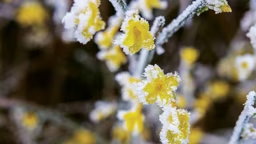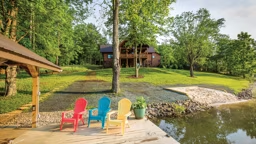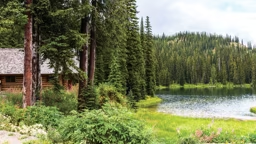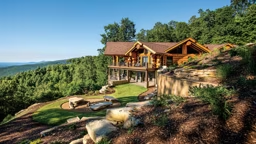What’s the first step to take when homeowners are ready to landscape?
 You’ll want to play up the natural features that your land already has. When I come to a new property, I scrunch up my eyes and think about things abstractly. What’s really beautiful here? What do I want to direct people’s eyes to? And what do I want to hide? Look at all vantage points from your house. Standing in your living room, figure out if there’s an ugly wellhead you’ll want to hide. Think about covering that up with stones and shrubs.
You’ll want to play up the natural features that your land already has. When I come to a new property, I scrunch up my eyes and think about things abstractly. What’s really beautiful here? What do I want to direct people’s eyes to? And what do I want to hide? Look at all vantage points from your house. Standing in your living room, figure out if there’s an ugly wellhead you’ll want to hide. Think about covering that up with stones and shrubs.
Also think about landscaping your property so the sun works best for you. Locating a shade tree to the west of your home is helpful, since it blocks the harsh afternoon sun. Trees planted to the western side of your home also block northwest winds, which are very harsh.
When should homeowners plan their landscaping? After, before or during their home planning? Why?
Here’s how it works. You can design any house that you want and change it and move it around. But you can’t manipulate your land as easily. Find the best piece of land first and make sure it’s in the right setting. Work the house around the land. The land trumps everything.
When you’ve got snow on the ground, think about your landscape. I like to take my shovel and figure out my garden beds. I draw them in the snow, and then I can really see how big they need to be by mocking them up full-scale. It’s a huge help.
Are there garden designs that are easier to care for than others?
Your landscape design shouldn’t be formal, with lined up shrubs and lined up stones. For log homes, the gardens should look like it’s in line with the landscape and it’s been there forever—it should look like the log cabin came after the landscape. So use freeform, naturalistic shapes. People tend to be scared and timid when it comes to designing these beds. Be bold, because you should make big curves. Not a tiny little radius. That’s why it’s fun to draw to in the snow.
You also want to think about layering. Put the larger materials and plants in the back and then it bring it down to something smaller in the front. It will create a billow, and a little hill that settles the home into the landscape.
Set big, big stones. You’re dealing with a big house, in terms of the materials. Use big stones and set them into the bed. But don’t put them at the edges, so they’re lining beds like a string of pearls. Always root it into the ground. Make it look like it’s been there forever.
Any advice for homeowners who want to create their own ponds?
Creating a pond is great; it gives you a lot of soil to work with for your gardens. You can use the leftover soil to create mounds and change the grading around the house or around the pond. But, in terms of the pond design, think about the pond in relation to the size of the house. Make the pond bigger than you think it should be. Put some of your plantings around the pond, perhaps perennials. I have a great big pond and it’s the major focal point that we look at all the time. The wind rippling it or the surface reflecting the clouds.
Why is the site of a log home important?
Having a log home out in the open is kind of a mixed metaphor. There’s certainly good things about exposure, if you desire unencumbered views. But, at the same time, the home really doesn’t look like it belongs there. The one thing I would suggest when building a log home is to bring back the forest around it and plant large evergreens in clusters around the house. Your home should feel like it’s a part of the land it came from.
The other thing to think about is how you’ll access your home. For me, the best way would be to come across a clearing in the woods to find it there, rather than off to the side of a paved road. I also wouldn’t suggest siting it on top of a hill, but instead put it just below the brow, so you feel rooted into the landscape.
How can owners design a garden that complements their log homes?
One of the great things about a log home is you don’t necessarily expect elaborate gardens—nature is what you expect to find surrounding it. My family used to spend vacations at a cabin in the Adirondacks and the landscaping was simple—a lot of white pines, fallen needles, ferns and moss. If you have the kind of setting where it’s already beautiful the way it is, there’s not much you need to change or add.
On the other hand, if you’re out in the open, a wildflower meadow might be a good option. But keep in mind that that’s not necessarily a low-maintenance choice. Planting a hay field is another possibility.
For homeowners that want to take on gardening, how should they approach it?
Having your own little farmstead is a wonderful idea. People love to grow their own vegetables because it’s a way to be connected to the land. A vegetable garden should be south-facing so it has good light. A berry patch or a small orchard also can be low maintenance and beautiful.











